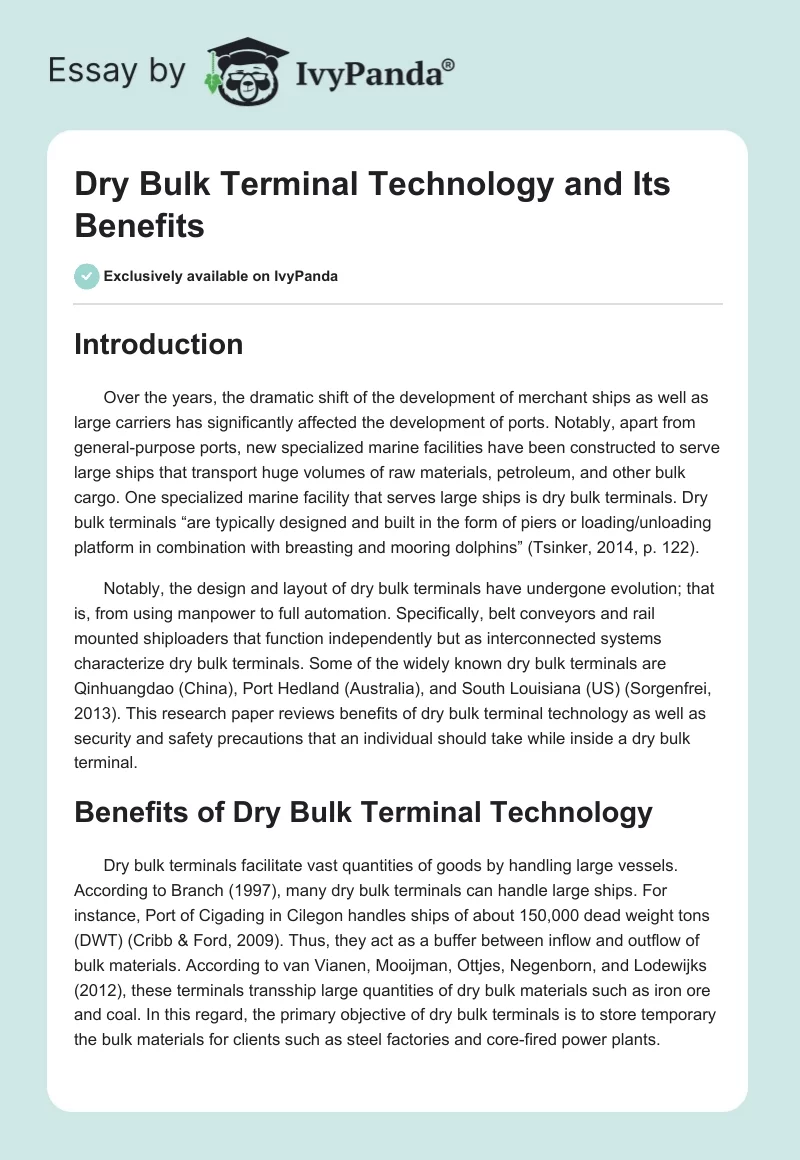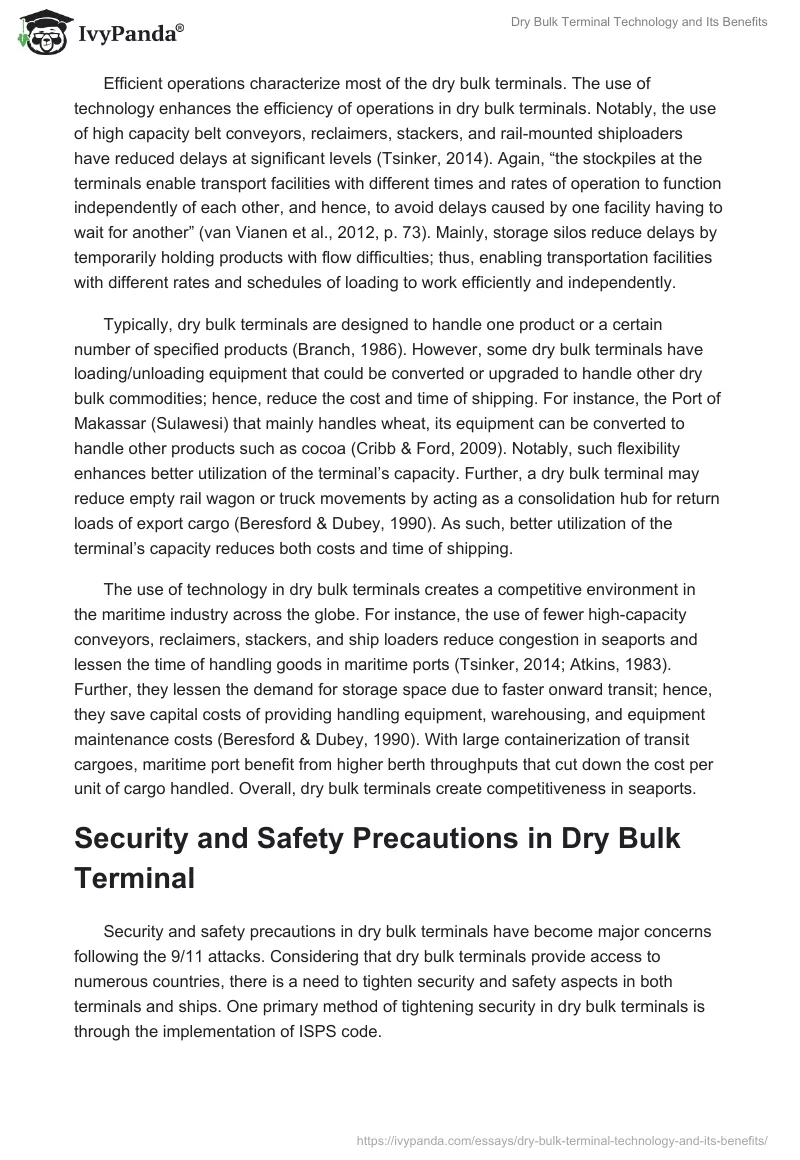Introduction
Over the years, the dramatic shift of the development of merchant ships as well as large carriers has significantly affected the development of ports. Notably, apart from general-purpose ports, new specialized marine facilities have been constructed to serve large ships that transport huge volumes of raw materials, petroleum, and other bulk cargo. One specialized marine facility that serves large ships is dry bulk terminals. Dry bulk terminals “are typically designed and built in the form of piers or loading/unloading platform in combination with breasting and mooring dolphins” (Tsinker, 2014, p. 122).
Notably, the design and layout of dry bulk terminals have undergone evolution; that is, from using manpower to full automation. Specifically, belt conveyors and rail mounted shiploaders that function independently but as interconnected systems characterize dry bulk terminals. Some of the widely known dry bulk terminals are Qinhuangdao (China), Port Hedland (Australia), and South Louisiana (US) (Sorgenfrei, 2013). This research paper reviews benefits of dry bulk terminal technology as well as security and safety precautions that an individual should take while inside a dry bulk terminal.
Benefits of Dry Bulk Terminal Technology
Dry bulk terminals facilitate vast quantities of goods by handling large vessels. According to Branch (1997), many dry bulk terminals can handle large ships. For instance, Port of Cigading in Cilegon handles ships of about 150,000 dead weight tons (DWT) (Cribb & Ford, 2009). Thus, they act as a buffer between inflow and outflow of bulk materials. According to van Vianen, Mooijman, Ottjes, Negenborn, and Lodewijks (2012), these terminals transship large quantities of dry bulk materials such as iron ore and coal. In this regard, the primary objective of dry bulk terminals is to store temporary the bulk materials for clients such as steel factories and core-fired power plants.
Efficient operations characterize most of the dry bulk terminals. The use of technology enhances the efficiency of operations in dry bulk terminals. Notably, the use of high capacity belt conveyors, reclaimers, stackers, and rail-mounted shiploaders have reduced delays at significant levels (Tsinker, 2014). Again, “the stockpiles at the terminals enable transport facilities with different times and rates of operation to function independently of each other, and hence, to avoid delays caused by one facility having to wait for another” (van Vianen et al., 2012, p. 73). Mainly, storage silos reduce delays by temporarily holding products with flow difficulties; thus, enabling transportation facilities with different rates and schedules of loading to work efficiently and independently.
Typically, dry bulk terminals are designed to handle one product or a certain number of specified products (Branch, 1986). However, some dry bulk terminals have loading/unloading equipment that could be converted or upgraded to handle other dry bulk commodities; hence, reduce the cost and time of shipping. For instance, the Port of Makassar (Sulawesi) that mainly handles wheat, its equipment can be converted to handle other products such as cocoa (Cribb & Ford, 2009). Notably, such flexibility enhances better utilization of the terminal’s capacity. Further, a dry bulk terminal may reduce empty rail wagon or truck movements by acting as a consolidation hub for return loads of export cargo (Beresford & Dubey, 1990). As such, better utilization of the terminal’s capacity reduces both costs and time of shipping.
The use of technology in dry bulk terminals creates a competitive environment in the maritime industry across the globe. For instance, the use of fewer high-capacity conveyors, reclaimers, stackers, and ship loaders reduce congestion in seaports and lessen the time of handling goods in maritime ports (Tsinker, 2014; Atkins, 1983). Further, they lessen the demand for storage space due to faster onward transit; hence, they save capital costs of providing handling equipment, warehousing, and equipment maintenance costs (Beresford & Dubey, 1990). With large containerization of transit cargoes, maritime port benefit from higher berth throughputs that cut down the cost per unit of cargo handled. Overall, dry bulk terminals create competitiveness in seaports.
Security and Safety Precautions in Dry Bulk Terminal
Security and safety precautions in dry bulk terminals have become major concerns following the 9/11 attacks. Considering that dry bulk terminals provide access to numerous countries, there is a need to tighten security and safety aspects in both terminals and ships. One primary method of tightening security in dry bulk terminals is through the implementation of ISPS code.
Notably, ISPS code constitutes several measures that aim at enhancing the security of port facilities and ships (The Maritime and Port Authority of Singapore [MPA], 2009). Mostly, dry bulk terminals should allow ships from countries that have already implemented ISPS Code. Besides, they should encourage other countries to implement the ISPS Code and other related safety regulations in seaports.
Again, individuals especially workers should notify security or other relevant officials about any suspicious activity or behavior. Notably, unusual cases such as a vehicle parked in strange place, or people taking photos of restricted areas should be reported to the relevant officials (Christopher, 2014). Again, an individual should know security procedures of the dry bulk terminal. For instance, if credential for access is required, then an individual should not visit restricted areas.
Besides, individuals in the dry bulk terminal should embrace open and unimpeded communications (Christopher, 2014). Notably, it is essential for individuals to be well informed about the operations and security of the dry bulk terminal. Again, they should be in a position to use available technologies such as email, radio, telephone and cell phones to transmit essential communications between terminal users and other relevant departments (Berle, Rice & Asbjornslett, 2011). For instance, an individual should be able to make 911 emergency calls at any given location within the dry bulk terminal in case of a fire, accident or terror attack.
People should be familiar with evacuation plans and routes of escape in the dry bulk terminal. The emergency evacuation plans relating to fires, unsafe conditions, bomb threats, and hazardous materials incidents should be known to dry bulk terminal users and workers so that they can act accordingly (Christopher, 2014). Further, an individual should understand the geographical layout of the dry bulk terminal so that he/she can provide landmarks, location, and routes when directing people to evacuation areas. Again, an individual should be aware of any updates relating to natural response plans regarding fires tornados, hurricanes, and earthquakes.
According to (Christopher, 2014), “rules pertaining to credentials, access to certain areas, hours of operation, documentation required, and so on, are an important element of the security of the [dry bulk terminal]” (p. 148). Thus, one should use individual based rules such as those relating to the utilization of protective equipment and safety gadgets like gloves, shoes, clothes, and glasses (Jadhav & Bal, 2008). In this regard, by following rules and ensuring that other people in the dry bulk terminal are doing the same create a strong security presence.
Conclusion
The dry bulk terminal has numerous benefits such reducing delays, facilitating large quantities of goods, compatibility, and low maintenance cost. Notably, dry bulk terminals handle large vessels such as those with 150,000 DWT. Besides, most of the dry bulk terminals do not need extensive maintenance, and thus, they are cheap to maintain. The dry bulk terminal is prone to accidents and security attacks from terrorists.
Therefore, security and safety precautions should be given priority. Usually, an individual should report to relevant officers about any suspicious activity, individual, or vehicle. Again, one needs to know the physical layout, evacuation plan, and routes of escape in the dry bulk terminal. Overall, there is a need to follow safety rules and guidelines pertaining to duty performance, using right tools for the right job, and visiting permitted areas only.
References
Atkins, W. H. (1983). Modern marine terminal operations and management. Oakland, CA: Port of Oakland.
Beresford, A. K. C., & Dubey, R. C. (1990). Handbook on the management and operation of dry ports. Geneva, Switzerland: UNCTAD Publications.
Berle, O., Rice Jr. J. B., & Asbjornslett, B. E. (2011). Failure modes in the maritime transportation system: a functional approach to throughput vulnerability. Maritime Policy & Management, 38(6), 605-632.
Branch, A. E. (1986). Elements of port operation and management, London, UK: Chapman and Hall.
Branch, A.E. (1997). Elements of shipping (7th ed.). London, UK: Stanley Thornes Publishers Ltd.
Christopher, K. (2014). Port security management (2nd ed.). Boca Raton, FL: CRC Press.
Cribb, R. B., & Ford, M. (2009). Indonesia beyond the water’s edge: Managing an archipelagic state. Pasir Panjang: Institute of Southeast Asian Studies.
Jadhav, R. A., & Bal, A. K. (2008). Safety guide lines for port users of Mumbai Port. Mumbai, India: Mumbai Port Trust.
Sorgenfrei, J. (2013). Port business. Norderstedt, Germany: Books on Demand (BOD).
The Maritime and Port Authority of Singapore (MPA). (2009). ISPS (International Ship and Port Facility Security) Code. Web.
Tsinker, G. (2014). Handbook of port and harbor engineering: Geotechnical and structural aspects. New York, NY: Springer.
Van Vianen, T. A., Mooijman, D. L., Ottjes, J. A., Negenborn, R. R., & Lodewijks, G. (2012). Proceedings of International Conference on Networking, Sensing and Control (ICNSC) ‘2012: Simulation-based operational control of a dry bulk terminal. Beijing, China: IEEE.


